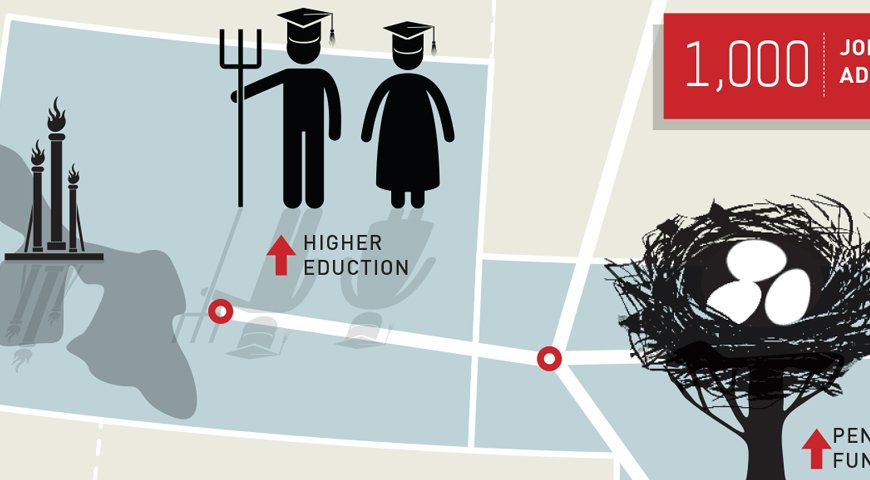After the housing bust and financial crises that erupted in late 2008, it quickly became clear that some regions of the country were so burdened with debt, a full rebound anytime soon was impossible. States such as California, Florida, Arizona, Nevada, Illinois and New Jersey had some of the most highly indebted residents in the country, and their governments were awash in red ink too. Their recovery would be plodding at best.
But the story is much different in the central corridor of the country. The states here didn’t spend or borrow themselves into oblivion during the housing boom, and as a result they’re enjoying a surge in economic growth and job creation. With clean balance sheets, probusiness governors and proximity to cheap energy and labor, the following seven states are growing as fast or faster than emerging markets like Brazil, Russia, India and China. These are the new states of American prosperity.

TEXAS
The Lone Star state has recently been welcoming a flood of people fleeing debt-ridden California. From 2009 to 2010, 12 percent of the people moving out of California moved to Texas, compared to just 1.5 percent from 2005 to 2009. Why? Besides the cost of living benefits— Texas has no state income tax and the average home price there is 60 percent less than in California—people are following the jobs trail. In 2012, Apple invested $300 million and added 3,600 new jobs in Austin, not at its Cupertino, Calif., headquarters. San Jose-based eBay also recently added 1,000 new jobs in Austin. And with infrastructure projects like a new $100 million airport terminal in Wichita Falls and a new $1.3 billion toll road connecting Austin and San Antonio, more businesses and jobs are likely to follow.
NORTH DAKOTA
The natural gas boom in the U.S. has created a thriving economy in North Dakota, one in which fast food joints pay high school kids $20 an hour and young oil workers pull in $100,000 a year. From 2008 to 2011, North Dakota’s economy grew by 27 percent, while the U.S. as a whole grew 6 percent. In the same time period, personal income grew by more than 10 percent and home prices increased 17 percent. North Dakota’s economy is so robust that there are not enough people to fill all of the available jobs, making hiring the biggest business challenge. The state has the lowest unemployment rate in the country at 3.3 percent.
INDIANA
Indiana’s economic strength is largely due to former governor Mitch Daniels. During his tenure from 2005 to 2012, Daniels worked to improve Indiana’s financial condition and make the state more attractive to businesses. Through its lower taxes and right to work law, Indiana has picked up more jobs (14,500) from mobile business investment (investments not tied to a specific place) than New York (12,300). Toyota announced in 2012 that it was moving production of the Highlander from Japan to Indiana, a $400 million investment. Also during the Daniels administration, Indiana improved its balance sheet so dramatically that the state earned the highest bond rating among states from all three major credit rating agencies.

WYOMING
Thanks again to the boom in natural gas, as of February 2013, Wyoming had an unemployment rate of 4.9 percent, the fifth-lowest in the U.S. The state and local tax burden as a percentage of personal income in Wyoming is only 8 percent, and Wyoming has no individual income tax. Wyoming’s per-capita spending on higher education is the third-highest in the country, while at the same time, it has the least expensive public tuition at $3,917. Wyoming now boasts the fifth-highest per-capita income in the country, making it the only rural state in the top five.
NEBRASKA
In the face of declining tax revenues, weak investment returns and burdensome pension obligations, few states have healthy pension funds. But Nebraska has an impressive 83 percent of its pension funded and only $2 billion in unfunded liability. Combine that with 11 percent economic growth from 2008 to 2011 and the second-lowest unemployment rate in the country (3.8 percent), and Nebraska is in much better shape than the 29 states that are failing to meet the recommended pension funding contribution of 80 percent.
IOWA
Loan volume may be plunging in the coastal states, but in the middle of the country, states have done a better job at keeping consumer debt in check. In Cedar Rapids, for instance, the consumer loan volume in the fourth quarter of 2011 was 52 percent higher than in the same period of 2006, a sign of growing economic confidence on the part of both borrowers and lenders. Loans are not the only thing on the rise in Iowa: The state’s economy grew 11 percent from 2008 to 2011, and Iowa has added 1,000 jobs since the start of 2013. The only thing that has fallen is its unemployment rate, down to 5 percent at the start of 2013.
KANSAS
Most of the central corridor states are better than their coastal counterparts at cutting taxes, but Kansas might be the best of them all. In January 2013, the state dropped its income tax rate from 6.5 percent to 4.9—leaving neighboring Missouri fearful of a westward jobs exodus. Industries leading the charge of economic growth in the state include manufacturing, finance, healthcare and information technology.
Reprinted by arrangement with Portfolio, a member of Penguin Group (USA) Inc. Adapted from Fate of the States (c) 2013 by Meredith Whitney.







